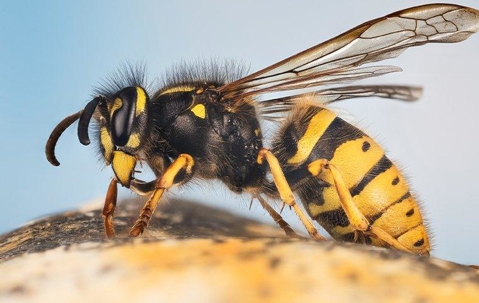Hurricane Helene’s severe flooding in western North Carolina has roused yellow jacket populations, increasing the risk of stings.
According to Chris Hayes, an extension associate in urban entomology at North Carolina State University, the rain and floodwaters most likely damaged the insects’ subterranean nests in addition to uprooting trees or stumps that served as nesting sites.
“Like many others, they are now homeless,” Hayes remarked. To address the issue, North Carolina health authorities stated they had purchased a significant quantity of EpiPens and Benadryl.
Summer Tonizzo, a press assistant for the state Department of Health and Human Services, sent out an email stating, “We are actively working to ensure Benadryl and epinephrine are readily available in western NC for those who may be allergic or have been stung.”
According to Tonizzo, the drugs will be given to the locals by hospitals, emergency medical services, and medical professionals.
She said that during a cyclone, it’s common for yellow jackets and other stinging insects to get momentarily interrupted.
Hayes said that while living in Wilkes County, in the western mountain part of the state, his parents had spotted yellow jackets on their land.
He stated, “[My mom] was texting me, ‘Hey, there’s yellow jackets all over these trees,’ while my dad was clearing some trees out of their yard.”
West Jefferson, North Carolina, registered nurse Tarren Pruitt, 42, reported that she has also observed yellow jackets everywhere she travels since the disaster.
Pruitt remarked, “When I take my kids outside, we can’t even stroll outside without seeing one or two.”
She went on to say that she is collaborating with churches to provide supplies, such as chewable Benadryl, to lineman in her region who have been reported to have been stung while attempting to restore electricity.
Although the majority of people are not allergic to wasp or bee stings, the location may nonetheless experience discomfort, irritation, or swelling. Benadryl can help lessen such symptoms when applied topically or when taken orally. Epinephrine injections, or EpiPens, are designated for those with severe allergic responses — such as problems breathing or swallowing — which can sometimes be life-threatening.
According to Hayes, yellow jacket allergies are common among persons allergic to bees, however the severity of the reaction may vary.

“Has flexibility so that people can get emergency refills on their prescribed allergy medicines,” stated Tonizzo about the North Carolina Board of Pharmacy.
She stated in the statement, “We are working to issue a standing order for Epi-pens so people can get medicines if they do not have a prescription from a provider.”
Yellow jackets are often more aggressive than bees, and they are able to strike individuals many times. Pheromones released by the insects alert other yellow jackets of impending danger.
According to Hayes, “They move very quickly to defend their colony and their hive from predators or any threat that they sense.”
He went on to say that this is particularly true in the fall when the first frost occurs and most yellow jackets, with the exception of the young queens, disappear.
This time of year, Hayes explained, “they tend to get more aggressive because food is becoming scarcer, populations are typically crashing, and they’re getting ready to overwinter.”
He noted that because clearing fallen trees may have made it more difficult for yellow jackets to obtain food sources like nectar, the storm’s consequences may have made some colonies even more problematic. Furthermore, the remainder of the yellow jacket queen’s colony may be flying around aimlessly if she was killed by the extreme weather.
Hayes stated, “Populations are just kind of spilling out, so you don’t have one yellow jacket on this tree, you have 300 of them.” “Even for those who are not extremely allergic, they can mount a response very quickly that can be very dangerous.”
The National Park Service advises cautiously leaving a disturbed yellow jacket nest while covering your face with both hands to save delicate regions.
In western North Carolina, Hayes advised people to either wait until the insects had left the region or until night, when they are less active, before cutting down trees.
Individuals who are extremely allergic to bug venom should always carry EpiPens and seek medical help right away if they are stung.






